Customer Success Using HubSpot Service Hub: The New Way to Win
- Home
- Customer Success Using HubSpot Service Hub: The New Way to Win
We're going to talk about customer success in 2020, and we're then going to go through a few success strategies, keeping in mind that there are a ton of strategies that we could cover on customer success. We're going to target about three that anyone can start to apply immediately, so we really want to make sure you can walk away with an actionable strategy you can start using. We're then going to pair that with optimising your HubSpot tools to get that going.
With this, you can use all of your HubSpot tools – from contacts to automation to the way even you manage your database to be optimising for customer success. To make sure we have some focus here, we've chosen about three or four tools that we think are most important for your customer success strategy for you to start using. We're then going to go through some next steps and resources and with the time left, go through some questions. We're also going to be talking about some of those new HubSpot tools and things to keep in mind. Let's get started!
Today's intention is summarising the importance of customer success in 2020, implementing those HubSpot tools and strategies to attract, engage and delight your current customers and turning them into your best marketers.
Our goal is for you to walk away with at least one strategy and one tool for you start implementing to be able to turn your customers into your best marketers. Who has consumed online educational content in the past 12 months? Has anyone consumed HubSpot Academy educational content in the last 12 months? How many have a strategy for customer success that includes educational content for your customers?
Maybe not all of you, maybe you're thinking about it and maybe there's some opportunity to continue to do so. That's probably why you're here – to think a little bit more about that. While today we're not going to dive far into education itself, keep in mind educational content’s importance for your customers. All of you I know are experts in something that your customers would benefit from and so when you start to think about customer success and the content you're planning for them, what is that educational content that you want to be providing?
What does customer success look like in 2020?
Let’s dive into customer success in 2020 and spend a few minutes talking about what it looks like this year. Our world is always changing and so as we enter into new years or we talk about different quarters, what does it look like today?
- Knowing Your Customer – As we think about customer success, you want to make sure you have a really good understanding of who that ideal buyer persona is. I have this warning here because while we're not going to dive into that today – we're not going to go through identifying your buyer persona is or looking at that ideal customer – one thing to keep in mind as you leave here is if you're not sure about what that ideal customer looks like, make sure you and your organisation, your teams, are really building that out. This is because as you review that, it's going to be what sets you forward and building out a lot of these customer success strategies in 2020 and beyond.
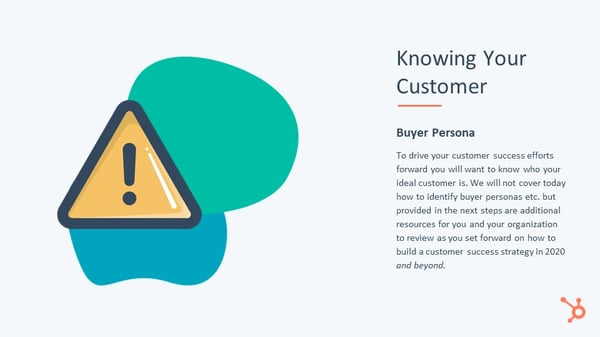
If you have any questions or thinking “Oh, I'm not sure, maybe I sort of have an idea,” make sure you review that and it is included in some of the additional resources that we have for you. When we look at companies that offer first-class customer experiences, they tend to grow faster and are more profitable. These companies are also 80% more likely to retain customers. Now there’s a key word in this sort of statistic or thought, and it's not customer support but customer experiences, and that's where we're going to spend a decent amount of our time talking about today because it's not about how you service your customers – it’s not about how your customer facing teams are servicing your current customers – but it's how you're crafting a full experience across attract, engage and delight for your customers as they enter in and continue to retain.
- Inbound Methodology – That's where we like to start with our inbound methodology. You've probably seen this. If you’ve engaged with HubSpot for any period of time, it's probably come up in blog posts, or documentation that you've read. The inbound methodology is really that method for growing an organisation by building those lasting relationships with the people and helping them reach their goals. It’s about thinking how when your customers succeed, you succeed. That's such a great way for us to talk about customer success because the inbound methodology really sets us up to look at this from that effect of attract, engage and delight – really taking those current promoters and those customers and being able to attract new people to your business. Attracting new customers by delighting your current customers is what's going to turn them into promoters and eventually equal that success on that sort of curve that we see at that top.
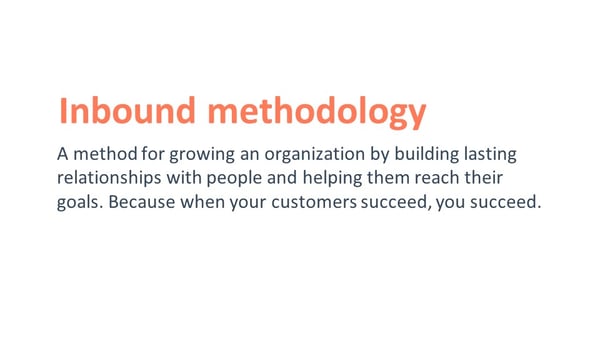
In the past we've talked a lot about how getting your customers in the door and getting them there has been the way to win at business. Now, we really want to help them almost become a part of your company to help you continue – it’s the flywheel effect. That brings us to our flywheel, the model that HubSpot has adopted and adapted to explain the momentum you gain when you align your entire organisation around delivering a remarkable customer experience that produces the happy customers that are able to turn referrals and repeat sales.
This momentum is so important when we talk about customer success because this is really the goal. We want to be able to spin that flywheel to make sure you're gaining momentum from all the work you've done to gain your customer, whether that's a customer who's purchased a product or a service. Maybe they're going to become a repeat customer in a month when they purchase a new product from you, whether that be from a t-shirt or an experience that you've worked with them or it's someone who's going to become a referral.
You think about those larger purchases someone might make. When you buy a refrigerator, you’re not necessarily going to buy a new one, but you can become a referral to someone else. When we think about the flywheel, we really start to focus in on this idea that more happy and loyal customers mean reduced churn rates. Reducing that churn and increasing customer retention is directly going to impact your bottom line. You'll see the boost in revenue by retaining those customers and it keeps your flywheel spinning.
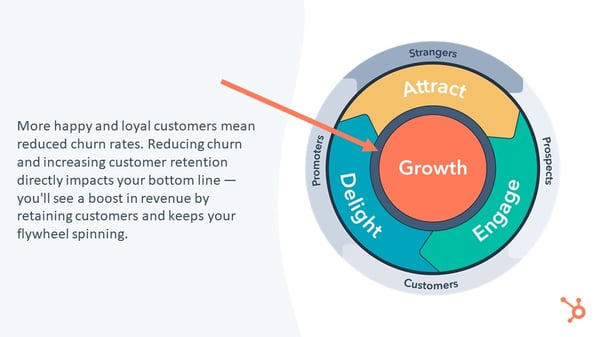
Think about the last customer who became a customer, whether they purchase something, they got their service, whatever it may be. Think about how long it took them to get there. The effort you and your organisation, your team members, did to get them there. Now, by not focusing on them, a lot of that work could go to waste in the next six months if you're not utilising the efforts that you put in. But if you're focusing on them and focusing on that growth perspective, then you're really using them to keep that momentum going.
- Word of Mouth: When we look at this, we also see that word of mouth referrals are the biggest growth lever for SMBs. We see that they produce 73% of the biggest drivers for growth. When you think about your company and the goals that you have, that word of mouth referrals and customer referrals is also driving a lot of your traffic and also the biggest opportunity for growth for you because they're your best marketers, your best sales people, and they're also your best service people. When we dive into customer success, we want to keep all of this top of mind. It's not just about the customer-facing team, it's not just about the efforts you put in there, but really thinking about the full flywheel and full inbound methodology effect you can have on your current customers.
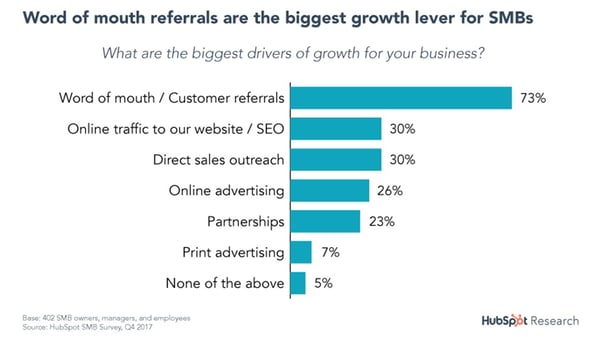
When you think about attracting, creating that content to start those conversations and meaningful relationships with the right people, this is a customer success play. Making sure the right content is there. As we're going to talk about in a little bit, one of the strategies in attract could be your current customers creating this content because they are experts in how they use your product or service and can be shown as a great example.
In engage, this is another opportunity for your current customers to engage with potential customers. Whether this be public-facing feedback or survey opportunities where your current customers are able to be put on the spotlight of showing, “Well this is why I use this product or service and you should too.”
Of course the biggest bucket that we always talk about is delight, making sure you have programs and developmental aspects of your company that really target your current customers to continue to delight them, whether this be communities – this is a great example of a community that we want all of you to be a part of – but other communities that you're building or other aspects of your business in which they can engage with.
The inbound methodology is really about bringing your business to empower your customers to help you attract, engage and delight, making sure that's not just the effort of you, but everyone in your ecosystem, including your current customers. Like we said, while we're not going to dive fully into this, that education piece can be the force you apply. We're going to talk a little bit about customer training as well as HubSpot tools such as the Knowledge Base that can provide that education to your customers to become your best marketers.
- Customer Success: All Teams All Hubs – When we think about customer success in the context of HubSpot, it's all teams and all hubs. Whether you're using marketing hub, sales hub, service hub, all hubs, just the CRM, maybe you're just using some things in the ecosystem, whatever it is, all of these things are focused on customer success because that success of your customers is not just the role of your customer team. It should be the focus of all your teams to attract, engage and delight at every stage of your customer journey with you.
Really keep in mind that when you think about your customer teams, how many of you are actually customer-facing or how many of you want to be involved with customer-facing teams to help drive this forward.
Here's a definition of what customer success is: it is the process of anticipating customer challenges or questions and proactively providing solutions and answers to those issues prior to them arising. It helps you boost customer happiness, retention and increases your revenue and customer loyalty. The difference here is that customer support and customer success are different and we want to make sure we keep that talk top of mind.
When you think traditionally about customer support, it focuses on working reactively on the front lines. Something has occurred. Your customer brings that question forward and you react to it. Customer success, however, is proactively working towards what your customers need throughout their time that they are a customer – getting feedback on them as well as making sure they get the most value out of their purchase with you. It's going to drive their experience forward and ensure a successful path in their future.
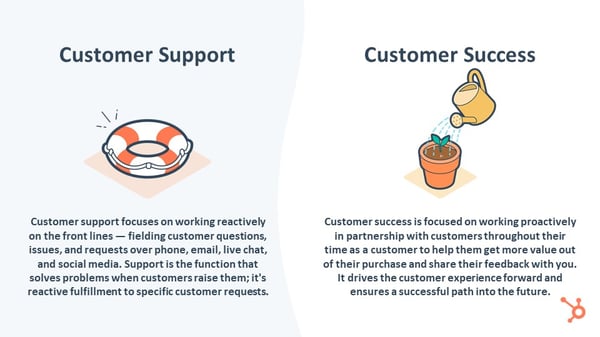
Keep these in mind. We always like to think about customer support, as you can see here, as your lifeline. It's a thing your customers can grab onto in times of uncertainty whereas customer success is a proactive strategy in which you and your teams are moving forward.
Just a few stats to get us started: 60% of marketers surveyed that their company uses customer feedback to make business decisions. That's really when we start to see that all of this feedback that you're getting or all of these customer success proactive strategies are helping you – marketers, sales folks and other teams – make sure they're making the right business decision for your lifelong customers.
We love these two stats next to each other because the numbers are inverted. 86% of marketers reported that they collect customer feedback on an ongoing basis. Again, marketers reporting that they're getting customer feedback. It's not just your customer-facing teams. That really brings us to the three elements of customer success:
- Customer Success Solution: The first is your solution, the tool or software that you use. Maybe some of you use HubSpot, maybe you use some other tools, but really that first step is the solution that you're using to empower you to do all of these strategies.
- Dedicate Team Members to Focus on Customer Success: You then are going to have dedicated team members to focus on customer success. These could be a cross functional group of customer success. Maybe some folks in marketing, some sales or someone that's wearing a lot of hats where they're both thinking about marketing as well as customer success. You want to have people that are focused and dedicated to implement these strategies on your behalf.
- Customer Success Strategy: The last is your customer success strategy, which is what we're going to get into now.
Before we get there, just try to think about this. You want to identify your best customers, help them spread the word about how they use your products and tools so that you can turn your best customers into your best marketers and grow your business better.
Strategies for Customer Success
Like we said at the beginning, there's tons of strategies you can use for customer success. We're going to go through three that you can start to implement today where you can attract, engage and delight your customers. The first is customer training: training for customers, social proof and customers teaching customers. You're then going to look at advocacy programs where you can showcase your customers and have them be the ones that are spreading that word. Last is feedback. It is that breakfast of champions. We want to make sure you're seeking the feedback to improve your experiences for your customers and they're telling you what they need from your company, your product, or your services.
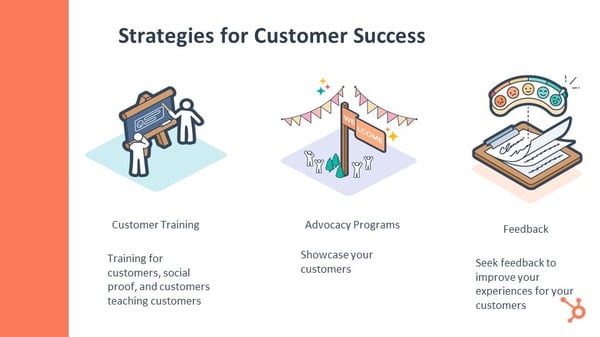
- Customer Training: When we think about training too, I like to make sure we have this differentiator here. There's a difference between education and information. Education allows performance of a skill with unaided recall and application of the knowledge learned across multiple topics and subtopics. The way that we like to think about this is if you're educating your customers, it's like that old analogy: you can give a man a fish and he'll eat for a day or you can teach a man to fish and he can feed himself and his family forever. This is really where education comes in. Teaching your customers to implement strategies or different ways to use your products and services.
Information is just as important. It's just going to have a different purpose in your customer success strategy. When you think about information, it's going to allow you to resolve uncertainty and answer questions. This can really be key for your customer support teams. We're going to talk a little bit about in those optimising of the tools, the ways in which you can help your customer support teams have the information to get these answers to your customers faster.
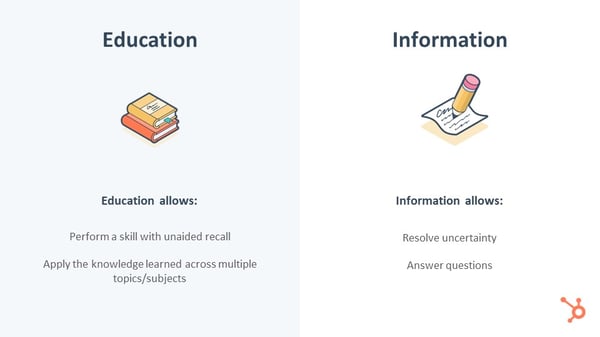
When you look at developing customer training, you want to be educating your customers about your products, your tools, your strategies that are relevant to their goals. Providing content on your website, on YouTube, on LinkedIn posts, webinars like this, in-person trainings or micro learning on your blogs or other key content platforms – really just sharing any information that you can as well as all the education in that customer training.
Here at HubSpot Academy, we do use an ADDIE framework, which is an instructional design framework to develop education focused on the learner’s objectives. This is key in helping us develop an educational content, and we want to share this with you as you think about education for your customers. It goes through five different steps: the first is analysis, the second is design, third is develop, then implement and evaluate.
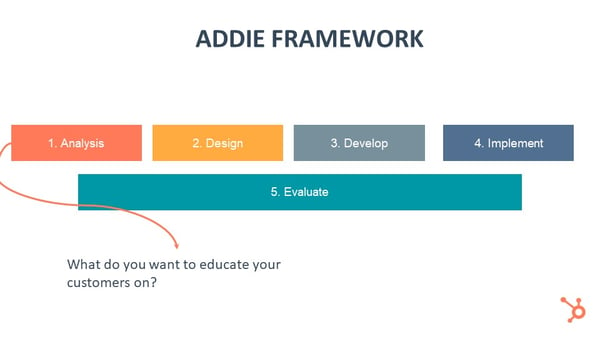
What it allows you to do is really structure the way that you think about the customer training you want to be providing because there's a lot of things that you could train on using this framework to help you really focus that in. In the analysis phase, it’s about what you want to educate your customers on. What's top of mind for them? What do you know they need to know or what are you uniquely positioned to make sure they're understanding about your products or your services?
- Analysis: Think about what you can teach your customers or your future customers about your business industry, products or services. Think about what you can teach your customers and future customers and the importance of that education piece.
How do you balance educating customers with giving away your hard earned experience and crm software free? This is definitely something that you should consider as you look to educate your customers, but that's really where you can use this ADDIE framework and we're going to get into that second phase too in developing the learning outcome. What do you hope that they achieve and how are you getting them there without necessarily giving away that experience but being able to be seen as that industry thought leader to be attracting them to your business?
Try to reposition that even just within your own organisation as “This is our experience, which is actually what's gonna make us that thought leader and hopefully attract more customers that are helping us be successful,” and that mutual balance there. That’s also where you can get into a conversation with your teams about what do you want to gate versus what do you want to have be un-gated. Maybe there's more content appropriate for un-gating first. There could be some things that you do want to gate particularly I think it terms of governance and security. There might be some balance there on what should be public information, but try to position yourself as that thought leader to balance that, educating your customers.
- Design: Once you take this first step in figuring out what you really want to educate your customers on, you go into the design This is really creating the plan for your educational content which is an outline with learning outcomes. An example of a learning outcome could be, “The learner will be able to implement HubSpot tickets to manage customer support questions,” really focusing on whatever that action is. What do you want them to do with the content that you give them instead of giving them education at will?
- Develop: Then you go into the develop phase. This is really producing your educational content. This could be video, written content, a webinar, maybe even a community post, whatever it may be, but you're developing whatever that aspect is.
- Implement: You're then implementing it, you're sending it to your customers, you're publishing it online, you're sending e-mails, you're getting it out there to, to whoever it is. This could come in the form of a campaign or it could be more proactive where you're just constantly publishing educational content. A good example of this would be HubSpot Academy, which gets everything out there on a rolling basis
- Evaluation: Arguably the most important piece is evaluation. You want to make sure that you measure the impact of this customer training. How many customers engaged with it, did their usage of your tools or service improve?
A good example is hosting webinars. How many attendees are here? How many people are engaging and leaving to implement the strategies discussed? That would be a way to evaluate the success of the webinar’s educational content. With the ADDIE framework, you can really position your customer training to do so. Gettting out there, customer training can be quick and easy. There's lots of different ways you can do it. And when we get into the tools, we have some tips and tricks on ways that you can start to implement it today.
- Advocacy Programs: This is something that the industry’s – across the board and across the world – have been talking a lot about recently: how you create loyalty programs, identify your top customers, and really create exclusive experiences for those top customers, really create advocates to spin your flywheel is what we want to look at here.
This is where we want to hone in on providing community. Particularly in times like this, community is so important and if you identify your top customers, you can create a community for them to learn from one another, inspire one another and others and together create your best marketers. This could be as low-impact as creating a Facebook group for them. This could be investing in a community platform. This could also just be sending out a dedicated e-mail once a quarter to your top customers to try to get them to be introduced to one another, making those connections and allowing them to inspire others. That's really key in all of this. Your best customers, your top customers are really smart. Make sure that they know that they can share that.
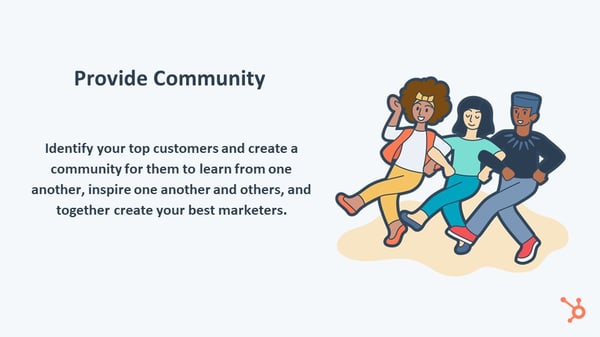
An example of this would be the 2020 HubSpot Champion User, something HubSpot Academy did recently. This is a good example of an advocacy program where we are identifying some of our top users of our products and our tools and giving them a credential to show that to the world on what they're doing. You can see here some examples of them posting on Instagram, LinkedIn, and Facebook and sharing that badge and that Champion User Award with the world.
This is really where users are seeing success with products or services. They're using your tools, they're the most engaged. Review what your ideal customer looks like and what are the behaviours indicating success. When you see what those behaviours of success are, you can then start to target them.
When we have advocacy programs, we're going to touch a little bit about on some tools there, but really start to think about what that ideal customer is for you and how you can put them on that pedestal and really showcase that.
- Feedback: The last is feedback and this strategy is so important because you can start to implement it right after today. I guarantee you that you can develop a survey and get it out to your customers in the next few days and start to get some of that feedback from them. Feedback is essential. It's either to keep us on the right track or get us back on track because we sometimes don't know where we are.
What do you want to know about your customer experience? As we're talking about customer success, start to think about what about your customer experience do you wish you knew more about? Is it their onboarding? Is it their purchase experience? Maybe it's what happened six months into being a customer.
Ref: Hubspot onboarding services
Think about what you and your organisation could benefit from knowing more about that experience. It could be things about your product or service that are unclear if your customers like. Brainstorm some questions you have that your customers can help you answer, like how was their first interaction with you and your company? What's that first experience like? Early signs if someone is dissatisfied – where are those hurdles? Something here that we're gonna touch on too is how you know what those hurdles are letting your customers you’re fixing them. That feedback loop is so important.
We think about this feedback, and there's three buckets that we put the feedback in for your strategy:
- The first one is the public-facing feedback on your website, G2crowd like websites, community threads, etc. This really builds trust and showcases your strengths as well as your ability to admit mistakes and look to resolve them. Public-facing feedback though, can be hard, particularly when you're not sure what it's going to be. But, if you're continuing to seek this feedback consistently, this is a great way to showcase it to your customers, that you're listening to them and that you're trying to fix it. If there's any opportunity for that public facing feedback, go for it.
- The second one, which is the lowest barrier of entry is surveys. It can be more targeted and personalised and the questions and responses provide the ability to follow up one-to-one. If you send out a survey and get these responses that you want, you can follow up with their customers in a more targeted way.
- The last, which is a little bit more time intensive is user interviews – getting on the phone with someone, seeing a screen share of their interaction with your purchase experience or their interaction with support or something that you're trying to target. These user interviews can be more time intensive but help solve larger questions that you have, particularly if you're just getting started with some of these customer success initiatives. These user interviews can be really key.
Broadly, it's very personal as well. You can do group user interviews, you can do it on the community or you can do it one to one, but this is really where you can leverage folks across your organization, whether it's a five person organization or a hundred people, you can really utilise everyone to get that going.
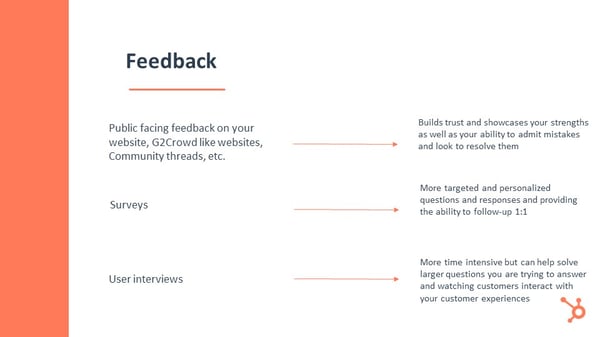
When you think about these three strategies – we've got customer training, we have advocacy and we have feedback – all three of these together are going to make the foundation of a great customer success strategy. You're educating your customers on what you want them to know. You're making sure that you provide an opportunity for your top customers to connect and become your advocates and promoters and you're constantly seeking feedback on how you can improve.
Optimising Your HubSpot Tools
What we're going to go through now is optimising your HubSpot tools to do this because those strategies are fantastic. You want to make sure you have the tools set in place to get them done.
There's all of the different tools that you can use to explore success. You can use the CRM, Contacts, etc. The following are a few examples of key tools to increase your customer success efforts and reach your customers in new ways: HubSpot video implemented in the Knowledge Base and your CMS, Surveys and Feedback, and Automation.
- HubSpot Video, Knowledge Base, and CMS: We have HubSpot video providing educational content and enabling success teams to share personalised content. This really targets that first strategy – providing customer training on both education and, for your customer support team, information to your customers. We look at customer success videos via support tickets to resolve customer issues and answer questions, really targeting that information piece of the customer training.
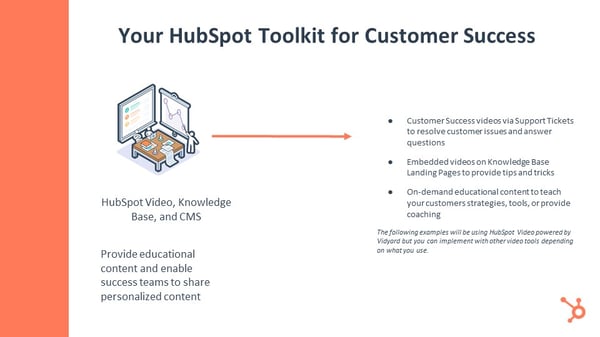
You can also embed videos in your Knowledge Base or Landing Pages to provide tips and tricks on how to be successful and On-demand educational content to teach your customers strategies and tools or providing coaching. The following few examples of what this looks like in HubSpot will be using HubSpot video powered by Vidyard. However, if you're not using those tools, no worries, all of this can still be applicable to you. You're just going to implement them with different video tools depending on what you use.
How do your customers want support? When we look at this, 68% of end users say that self-service is their preferred channel for support. Really enable the opportunity to make sure that your end customers have the opportunity to self-serve if they have a question. This is where we're going to look at the Knowledge Base and embedding it in the Knowledge Base videos.
When you think about a customer who has a question, you can start an article on, for example, how you install an integration, how to purchase or how to do something with your product or service, and you can embed a very interactive and personalised video right into that article. What you see here is the Knowledge Base video now embedded directly in to that page, which means that when someone comes to this article, they're going to be able to have that interactive experience and self-serve.
The next option two with that Knowledge Base is learning at their own pace, applying your tools and strategies as they’re executing on their goals. You can personalise that video to them and show them verse tell them to do something. Videos can also be shared with others easily. Customers influence their own networks on how you are supporting them. A good example of this could be someone hits that and they're like, “Oh my gosh, like look at this easy response I got, and now I can implement it,” and video is very easily shared.
The other example here is Ticket Videos. This is really key for providing easy and fast responses to questions customers do have. When we go here and we look at tickets: a customer reaches out, and then something that we have available here is they can either create a new video that is personalised directly to those customers or they can select from a library of common answers to questions that they may have. Not all of you may be using tickets yet, but if you're looking at the customer success implications here, being able to empower your customer success teams particularly the ones that are customer-facing to send personalised videos inside of their ticket responses increases their time and response rate, and makes it really easy for the customer to get the response they need.
When we look at that, you're enabling customer success team members to personalise their responses and you're creating a library of videos based on common questions for quick and easy responses to your customers. We would argue that this is the easiest thing that you can do to get started with customer success. You're enabling them to not only solve their problems, but giving them the resources they need to do it quickly and easily.
We also look at providing the space for your customers to share what they love about you, your product, your experience, and how they've grown with you. This can really provide that evidence of success and the delightful experiences. You can share that on YouTube. Twitter, you can utilise free video tools to encourage customers to share on the spot. You don't need productionalised case studies to do this. You can get your customers started sharing about their success and make your customers the stars.
A few examples of this could be pairing requests for videos or other content with an upcoming survey or newsletter you're sending. Asking them, “Hey, like how's it going? Want to fill out this newsletter?” or “This is what's new going on with our product and service. Record a video about how you like our company or how you enjoy working with our product or service.”
You can reach out on social networks. You can also, potentially for some longer content, offer a small gift. We have some example copy in here. You can also share with current customers as well. Not everyone uses your products or services the same way, so provide inspiration to others. You can then share them on your different platforms. These are just two examples, both from HubSpot. The one on the right hand side is someone who’s recently been taking some certifications while quarantined. The other one on the left hand side was a case study which we did. Both examples target this, making your customer the star, really making sure that they know what's going on and being able to have them share with the rest of your customer base.
- Surveys and Feedback: It’s really about that feedback being the breakfast of champions, evaluating your customer happiness, knowing where you are and what you can improve on and sharing this with your customers. We're going to go through three surveys to start with and look at the types of feedback to seek. First, we have customer satisfaction, which could be the purchase experience; the customer effort, which can be the automated ticket follow-up; and the net promoter score, which is where they're recommending your company to others.
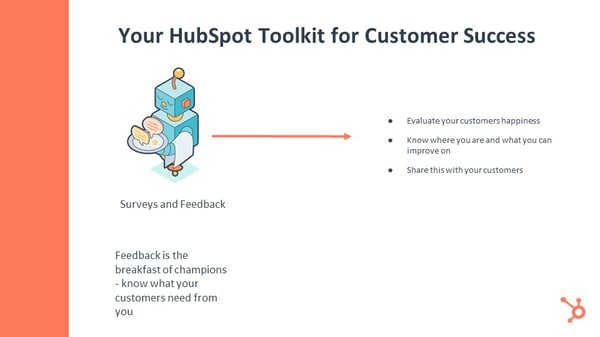
These three surveys are easy ones to get you started with. These are all examples directly from HubSpot that you can build. The customer satisfaction survey, it's simple. It's a three point rating just to see where they're at. The customer effort score can really target where folks get stuck or the effort to get an answer and looking at your support teams. The last, probably the most common, is the NPS – folks leaving that score on how likely they are to recommend your company, product, and service. This is one that can really easily be shared on public forums as well.
Let's craft a survey really quickly and show what creating a net promoter score survey looks like in HubSpot.
When soliciting feedback, one of the things that you can attempt is also making it more personalised. Limit the amount of customers that you're reaching out to to start with, to make sure that the experience is very personalised to them. This also goes back to thinking about who your customers are and which ones do you want to target for feedback. This can be really key when it comes to making sure you don't get that radio silence, finding the ones that have the behaviours in which you want to target.
As you can see here, building out this customer survey, in this case the NPS one, you’ve got lots of different options on the feedback, the “thank you”, as well as the recipients. You can adjust the feedback questions based off of if they're a detractor, a passive or a promoter. If someone is marking that as a promoter, that's a really good behaviour that they might want to give you even more feedback, so the language here is now being adjusted: “Also we'd love for you to share your experiences with others.” This is where you can be asking from them, when you’ve already received the behaviour and see that they're potentially a key target.
You can customise that “thank you” and make sure it looks the way you want. Directly in the survey, you can target who you want to send the survey to. It can be automated, it could be an e-mail. You can also set it to be recurring, if you want this to be happening pretty frequently. We recommend every three months, but maybe you want to adjust that. You can also decide when it's sent and who gets notified. In this case, I want to make sure I get notified anytime someone responds
The last piece is the automation, which is really the key part, which is what we're going to dive into briefly next, but making sure that you have an automated follow-up action for any of your survey responses. I really encourage anyone who's a detractor, you can follow up with them here. It can be an automated response. It can be personalised, whatever you're considering.
- Automation: That brings us to the automation, which is the last piece – automate support, ticket follow up, send automated surveys after key actions and optimise customer success actions. What you can see here is you can provide quick and personalised responses to gain that momentum with some of that automation. You can have an automated response when a ticket closes, so if someone has had an experience, you can really target that customer effort score there, or send an NPS survey to ask for feedback.
You can also utilise the sequences and template tools inside of HubSpot and your sales tools have a library of responsibilities to utilise during personalised follow-up with customers.
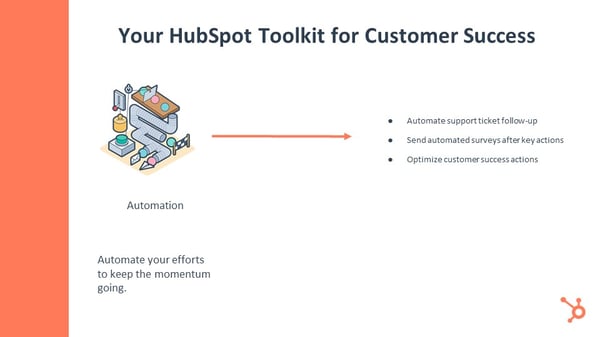
These are just some HubSpot tools that you can start to utilise and optimise when thinking about customer success and tying them to those three strategies. We have the HubSpot Video, whether you're using it, and Knowledge Base or the CMS, Surveys and Feedback, as well as Automation.
Next Steps & Resources
We want to make sure that you get some of those highlights of new HubSpot tools that are coming out. A few that we’re going to mention briefly as we head into the next steps and resources is our PieSync integration which does allow for a bi-directional sync between HubSpot as well as any of your other tools that you might be using outside of the HubSpot ecosystem. We just launched some educational content on it as well, so if you want to dive deeper into it you can.
A few of the other ones that you may have seen that have come out recently is our beta for Account Based Marketing tools, so if you are looking at that ABM type strategy, we do have some of those tools in beta. Attribution reporting is another large one which has come out a little bit further back, but still something really key to make sure that you're taking a look at. As you go through these next steps and resources, make sure you really hit that community post after to really dive into a lot of these new HubSpot features.
More importantly, as you continue to learn about the impact of customer success efforts and utilising your HubSpot tools to grow, we've put a list of resources here, a collection of lessons and courses from HubSpot and HubSpot Academy on how you can continue to really shape this experience for your customer. The two that we want to call out is “Mapping Your Customer Journey” and “How to Use HubSpot Video with Service Hub”. We really spent the most amount of time with both the strategy piece and HubSpot tools with these two to make sure you're really optimising those strategies for your customer base.
Make sure you visit the HubSpot community to discuss further and check out any of those other Academy courses and certifications that you have so you can continue to learn.

